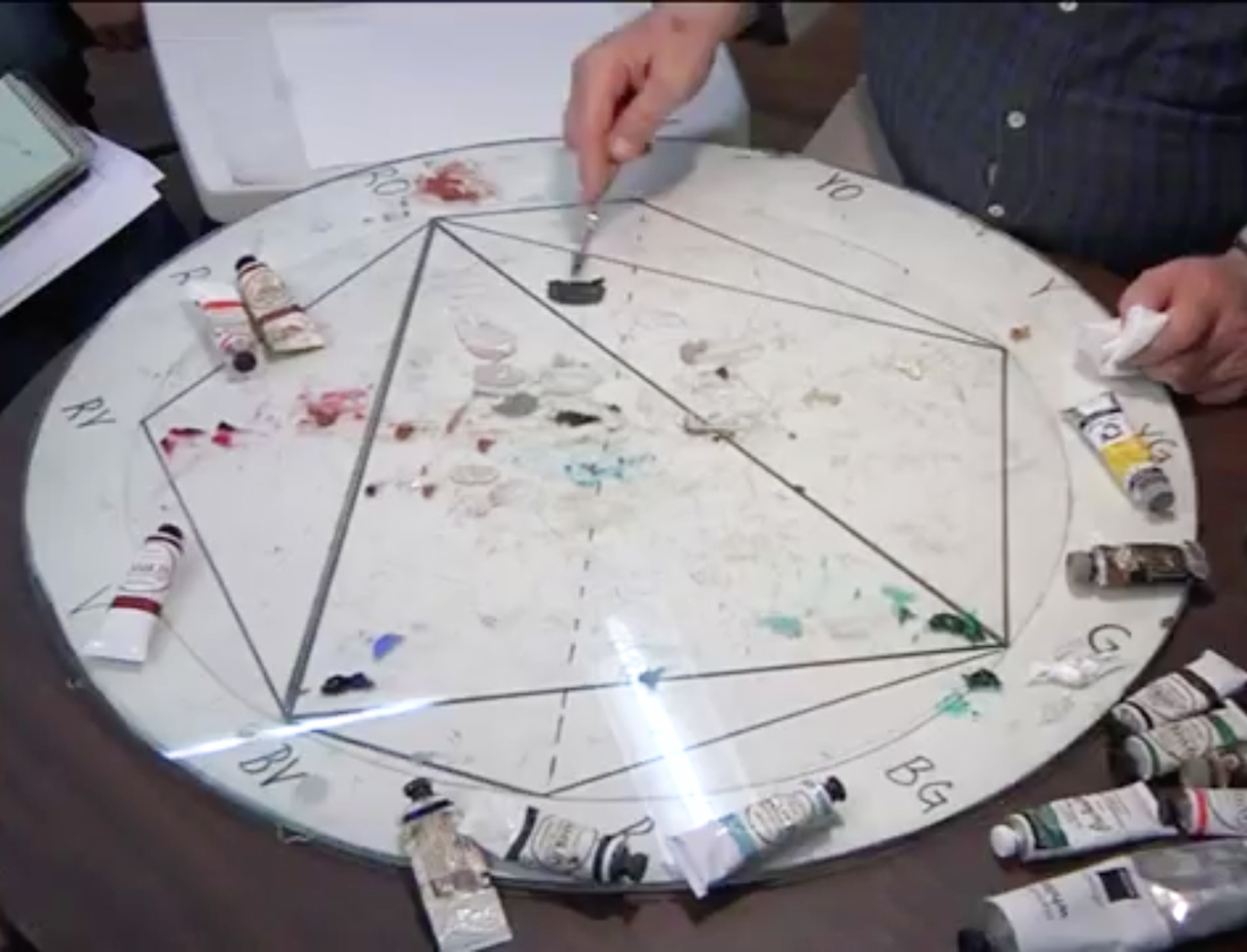About Palette Control & Color Theory Download
The following seven courses presuppose a sound understanding of the principles of drawing, value organization and design principles, all of which are offered in the foundation in drawing and design course.
Lesson One - Introduction to the Fletcher Palette
Lesson one introduces you the complex aspects and content of the color course at a high level. The concepts, tools and ideas that are presented in lesson one are broken down in subsequent lessons for deeper understanding but are presented in this first lecture to introduce you to the bulk of the ideas that form the color course and give you a chance to see what happens when you mix colors together.
Skill Set
- Introduction to color and the key components of the Barnstone Color Course
- Color mixing and observation using a color key
- Mix a palette in the Key of RO-G-BV
- Tune the triad, learn about secondary colors and the central neutral.
- Create a simple design for translating Fletcher color notations into color
- Paint a value step scale.
Lesson Two - The Fletcher Palette
In lesson two you will paint a full Fletcher palette on top of a neutral underpainting and create a second value step scale in paint along side. The purpose of this assignment is to explore and observe the color changes that are possible with this system.
Skill Set
- Mix a full Fletcher color palette
- Mix a 9 step value scale
- Understand the use of the various three point triangular color fields in a Fletcher palette
Lesson Three - Tipped Plains with a Value Underpainting
In lesson three you will begin to practice the process of matching the value of a toned underpainting and explore the 3D effects that can be achieved with value and contrast.
Skill Set
- Matching color to a value underpainting
- Using value to create space and movement
- Decode and practice the Edinburg color notation system from the Fletcher text
Lesson Four - The Twisting Plane
In lesson four you will continue to experiment with color and value, creating an exaggerated 3D effect of a twisted paper in space with only value and color changes as your tools.
Skill Set
- Mix neutrals to follow a schematic design
- Match values of an overpainting to its underpainting
- Practice variations in edge painting for your underpainting and overpainting
- Observe and practice the adjustment of value contrasts to affect color
- Observe and render the color changes along curving surfaces of form or atmospheric changes in space
Lesson Five - The Ship and a Light Show
In lesson five Myron demonstrates the effective use of low intensity palettes and some ways to train your eye through light experiments to more clearly see the effects reflected colors can have on a subject and how to capture those in a painting.
Skill Set
- Observe how the color of light on an object can be changed by altering the surroundings
- Applying color theory to recognize and describe the subtle shifts of hue, intensity and value.
Lesson Six - Independent Schematic Designs (One theoretical and one observed)
In lesson six you will have your first opportunity for original design of a schematic and learn more how to use the Fletcher method as a color planning tool both for creating original abstract work or to design and a still life.
Skill Set
- Analyze the Fletcher color wheel as a design planning tool
- Practice adjusting color nuances to enhance the color key and control the color zoning in a design
- Select and apply specific color keys for individual artistic intent
- Apply color theory and the Fletcher palette to an abstract design project
- Apply color theory and the Fletcher palette to an observed still life project
Lesson Seven - Final lecture
The final lecture in this color course follows a different flow and contains some insightful thoughts on the creative process and presents beautiful work by alumni with Myron's commentary that will allow you to practicing your new skills of observing and analyzing color.
Skill Set
- Practice observing works for analysis of color theory use
- Thoughts on continuing your art education and closing words
Before frightening the student with the notion that organizing the palette is difficult, let me quickly say we need only three pigment colors and white paint to get started.
The color theory and palette control videos, couple with the text by Frank Morley Fletcher, provide all the information needed to gain considerable control over the subject.
The fear that color control and color theory are complex and difficult are unfounded. We will only need three colored pigments and white paint to create the basic palette.
While watching the video series of lectures, please keep in mind that at no time do we place more that seven colors on the palette, and often we will only use four or five of those.
Buy 10 or above and get 25% off

Kathleen Swope –
I am an art teacher. I use the course not only for my professional development but also will be purchasing some of the recommended texts for our school library. My hope is to create interdisciplinary art/ math projects.
Sean Delonas –
Very briefly studied at Barnstone Studios in the early 1980’s. Myron was the first art teacher I had who actually taught art in a serious manner. I’ve worked as a professional illustrator/fine artist ( http://www.SeanDelonas.com ) for the past 30 years and still use what I learned from drawing those bottles. Thank you, Myron Barnstone.
Anonymous –
I am really enjoying the Palette Control & Color Theory series. It has really opened my eyes to new ways of seeing color. Thank you so much Myron for sharing this information.